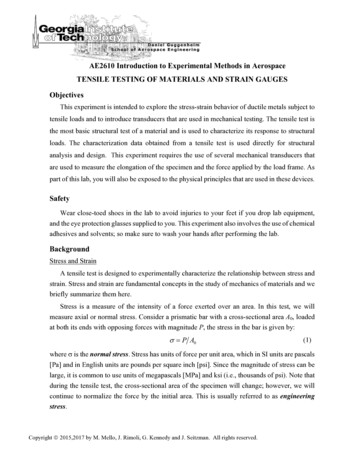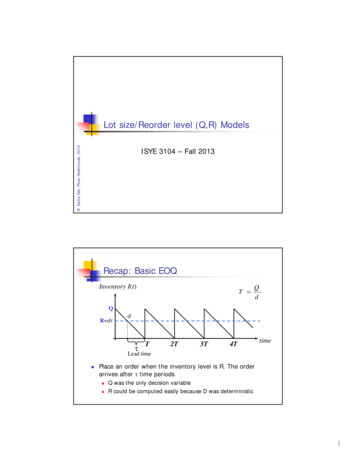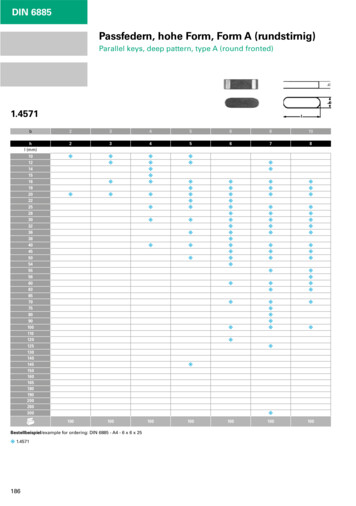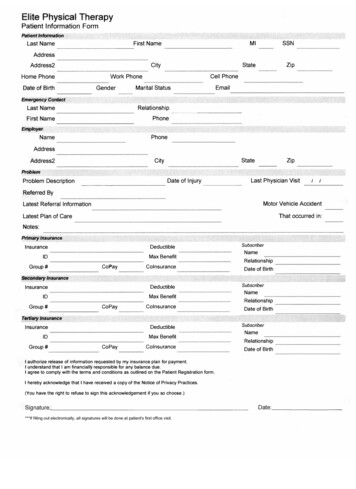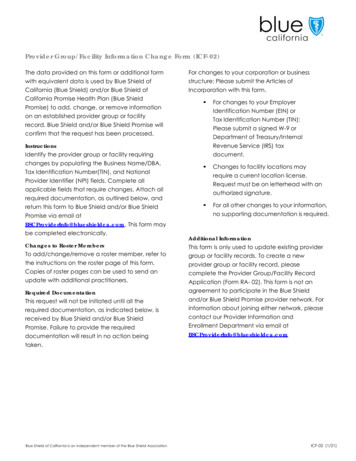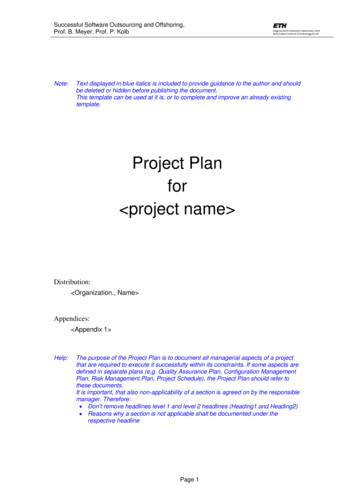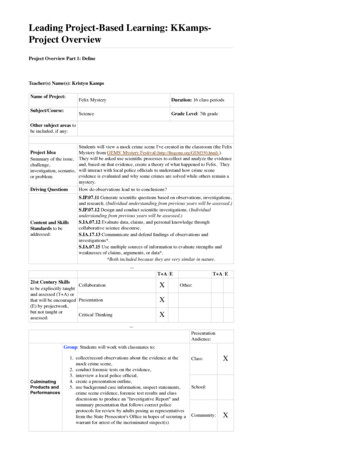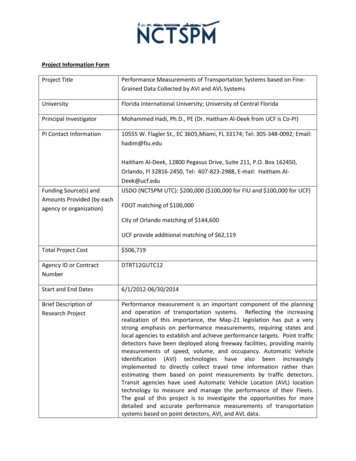
Transcription
Project Information FormProject TitlePerformance Measurements of Transportation Systems based on FineGrained Data Collected by AVI and AVL SystemsUniversityFlorida International University; University of Central FloridaPrincipal InvestigatorMohammed Hadi, Ph.D., PE (Dr. Haitham Al-Deek from UCF is Co-PI)PI Contact Information10555 W. Flagler St., EC 3605,Miami, FL 33174; Tel: 305-348-0092; Email:hadim@fiu.eduFunding Source(s) andAmounts Provided (by eachagency or organization)Haitham Al-Deek, 12800 Pegasus Drive, Suite 211, P.O. Box 162450,Orlando, Fl 32816-2450, Tel: 407-823-2988, E-mail: Haitham.AlDeek@ucf.eduUSDO (NCTSPM UTC): 200,000 ( 100,000 for FIU and 100,000 for UCF)FDOT matching of 100,000City of Orlando matching of 144,600UCF provide additional matching of 62,119Total Project Cost 506,719Agency ID or ContractNumberDTRT12GUTC12Start and End Dates6/1/2012-06/30/2014Brief Description ofResearch ProjectPerformance measurement is an important component of the planningand operation of transportation systems. Reflecting the increasingrealization of this importance, the Map-21 legislation has put a verystrong emphasis on performance measurements, requiring states andlocal agencies to establish and achieve performance targets. Point trafficdetectors have been deployed along freeway facilities, providing mainlymeasurements of speed, volume, and occupancy. Automatic VehicleIdentification (AVI) technologies have also been increasinglyimplemented to directly collect travel time information rather thanestimating them based on point measurements by traffic detectors.Transit agencies have used Automatic Vehicle Location (AVL) locationtechnology to measure and manage the performance of their Fleets.The goal of this project is to investigate the opportunities for moredetailed and accurate performance measurements of transportationsystems based on point detectors, AVI, and AVL data.
The project has examined free-flow speeds and their distributions alongthree corridors, including two freeway corridors (I-95 and FloridaTurnpike) and one arterial street (US-1). The free-flow speeds for the I-95corridor and US-1 were estimated based on the detector data andBluetooth data, while the free-flow speeds along the Florida Turnpikewere I-95 and US-1 were estimated from the detector and toll tag datadue to the data availability. The K-S tests were conducted to test thenormality of free-flow speed distribution and also test if two free-flowsequences come from the same distribution.The differences between travel time estimates from detector data andAVI data (including Bluetooth data and electronic toll data) underdifferent traffic conditions and different route lengths were examined inthis project. Also, in order to determine the accuracy of disseminatedinstantaneous travel time information and thus the potential benefits ofutilizing predictive travel time modeling, this study investigated thedifference between instantaneous travel time and experienced traveltime.Various methods were developed in this project to estimate queue lengthand density, including methods that are only based on traffic detectordata, or only based on AVI data, or combination of different data sources.The developed methods were applied to the roadway segment along theFlorida Turnpike using real-world data. Meanwhile, a micro simulationmodel along the SR-826 was conducted to assess the estimation accuracyof each method.At the same time, the project is evaluating Transit Signal Priority (TSP)based on AVL data. The main goal of this research part of the project isto evaluate the benefits of TSP on transit operations in terms of:Improvement in bus travel time through International Drive (I-Drive), areal life corridor in Orlando, Florida, and bus adherence to schedule byreducing its travel time variability. Furthermore, this research willexplore reduction in bus emissions which is expected to increaseenvironmental sustainability. The research team has collected trafficdata in the above corridor, and also collected “Before” and “After” TSPon-board bus data and reviewed signal pre-emption logs to determine ifconditional TSP improves transit schedule reliability and adherence. The“Before” and “After” study has been completed. Statistical analysis andcomparisons between “Before” and “After” conditions have beenevaluated. The TSP effectiveness has also been evaluated using VISSIMsimulation. Sensitivity analysis has been conducted using VISSIM.Several scenarios have been tested to optimize the amount of bus traveltime delay while TSP is activated. Signal operations and effect oncrossing streets have been evaluated to determine that there is nodeterioration in operations for crossing street traffic while TSP is
activated.This research is expected to have important impact on bus patrons of areal world transit corridor. With the help of TSP implementation in thishigh tourist corridor, it will be determined in future years if TSP canincrease bur ridership due to improvement in level of service, and if it canincrease environmental sustainability by reducing bus.Describe Implementation ofResearch Outcomes (or whynot implemented)(Attach Any Photos)Results will be presented and discussed with FDOT, Lynx, and City ofOrlando.Data exploration was performed from field data collected for each TSPscenario: No TSP, Unconditional TSP, and Conditional TSP with trafficsignal red delay and passenger stop delay.Using Data Exploration in the Unconditional TSP, four of the five TSPsignals experienced an average delay reduction in the eastbounddirection, and three of the signals experienced an average delayreduction in the westbound direction. During Conditional TSP, two of theTSP signals experienced an average delay reduction in the eastbounddirection, and three of the signals experienced an average delayreduction in the westbound direction.Bus trajectories shown in the following two figures is based on theaverage speed through the corridor showed that both Unconditional andConditional TSP reduced the average travel time through the segment ofthe corridor where the TSP signals were concentrated. The eastbounddirection experienced a 9.9% travel time reduction during theUnconditional TSP and a 13.7% travel time reduction during ConditionalTSP through this corridor segment compared to No TSP. For the samecorridor segment, the westbound direction experienced a 9.7% traveltime reduction during Unconditional TSP and a 0.2% travel time reductionduring Conditional TSP compared to No TSP.
Due to small sample size collected in the field, it was necessary toenhance field data analysis with VISSIM simulation model to determine ifTSP met the objectives of this project.Several scenarios were developed utilizing the data collected andinformation from the City of Orlando to optimize the behind scheduletime for the bus. VISSIM was used to model the No TSP, UnconditionalTSP, and Conditional TSP with 3 and 5 minutes behind schedule.Compared to the No TSP, Unconditional and Conditional 3 and 5 minutesscenarios showed improved travel time savings. Unconditional TSPshowed the greatest travel time savings but issues occurred with the
increase of side street delays when the Unconditional TSP was activated.Conditional TSP 3 minutes was better in travel savings than ConditionalTSP 5 minutes for both east and westbound travel directions.We also developed route travel time savings through the VISSIM models.Compared to the No TSP, all three scenarios of Unconditional andConditional 3 and 5 minutes showed improved travel time savings.Unconditional TSP showed the greatest travel time savings but thatincreased signalized side street delays when the Unconditional TSP wasactivated. Conditional TSP 3 minutes was better in travel time savingsthan Conditional TSP 5 minutes for both east and westbound.Based on our research we can conclude that TSP was beneficial for transitoperations in the I-Drive corridor under study by ensuring that busesbehind schedule are granted signal priority. This contributes to a betteradherence to the bus schedule and increases transit reliability. It was alsopossible to provide a better understanding of how TSP effects changewith different traffic conditions.Using VISSIM simulation runs, it was possible to model the overallimpacts of the TSP system on the local traffic network and effects on sidestreet signal delay. This showed that Conditional TSP with 3 minutesbehind schedule did not adversely affect the signalized side streets as thisConditional priority improved the operations of I-Drive. It also showedthat the average number of stops were reduced using Conditional TSPwhen compared to No TSP. Presumably fewer vehicles stopping willrepresent a smoother traffic flow and less risk of vehicle to vehiclecrashes.Testing TSP while operational in a real world setting is necessary beforethe TSP system can be expanded beyond the I-Drive corridor. In the eraof government budget constraints it is necessary to show that a systemwill work and can be effective before any expansion can occur.Expansion of the TSP system without proper testing, modeling andcareful evaluation can be a costly endeavor. The agencies responsible forfuture expansion have to ensure that expansion of the TSP system is costeffective and beneficial to their patrons in reducing travel time andimproving schedule reliability. Through our research, it wasdemonstrated that by reducing bus delay and decreasing travel time, TSPcan lead to a more sustainable transportation system. As a componentpart of the transportation system, TSP is a method to create a moresustainable transportation system by increasing bus efficiency in reducingbus delay and reduction in bus travel times as was shown in this research.Even though there is no one solution to reduce the transportationcontribution to greenhouse gases and global warming, the transportation
sector can improve vehicle efficiencies and diversification oftransportation options to reduce emissions. A method to reduce possiblevehicle emissions is to develop a more efficient transit system because ofTSP. This has the potential to decrease individual vehicle usage, so therecould be an improvement to the efficiency of the transit system byincreasing ridership. It could also lead to a decrease in greenhouse gasesand thus reduce the rate of temperature increases and sea level rise. TSPcan be effective in environmental improvements if used on a larger scalethroughout the United States and the World.Impacts/Benefits ofImplementation (actual, notanticipated)Both FDOT and LYNX are looking at expanding TSP in several areasincluding areas surrounding the recent operation of the Sunrailcommuter train in Central Florida.Web LinksNone. ReportsProject website
can lead to a more sustainable transportation system. As a component part of the transportation system, TSP is a method to create a more sustainable transportation system by increasing bus efficiency in reducing bus delay and reduction in
